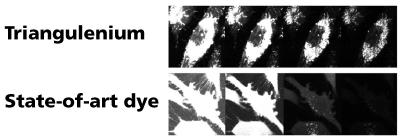May 13 2013
From microscopes to MRI scanners, imaging technology is growing ever more vital in the world's hospitals, whether for the diagnosis of illness or for research into new cures.
 Emission intensity images of human breast cancer cells, contrasting triangulenium dyes and the state-of-the-art long emission lifetime dyes. Where the state-of-the-art has completely stopped emitting at 30 ns, triangulenium still gives clear images after 30 nanoseconds and continues shining until the 100 nanosecond mark. Credit: Thomas Just Sørensen, Department of Chemistry, University of Copenhagen
Emission intensity images of human breast cancer cells, contrasting triangulenium dyes and the state-of-the-art long emission lifetime dyes. Where the state-of-the-art has completely stopped emitting at 30 ns, triangulenium still gives clear images after 30 nanoseconds and continues shining until the 100 nanosecond mark. Credit: Thomas Just Sørensen, Department of Chemistry, University of Copenhagen
Imaging technology requires dyes or contrast agents of some sort. Current contrast agents and dyes are expensive, difficult to work with and far from ideal. Now, Danish chemists have discovered a new dye and proved its worth against any of the dyes currently available.
Thomas Just Sørensen and Bo Wegge Laursen are chemists at the University of Copenhagen, Denmark. In a series of publications in well-regarded scientific publications, they have shown that the aza-oxa-trangulenium dyes have the potential to outperform all fluorescent dyes currently used in imaging.
"Our dyes are ten times better, far cheaper and easier to use. The latter I believe, will lead to expanded opportunities and broadened use, by physicians and researchers in developing countries, for example." Says Thomas Just Sørensen.
Visual noise blocks correct diagnosis
It might seem odd, but one of the central challenges when taking pictures of cells and organs, is to avoid noise. The agents that make it possible to see microscopic biological structures are luminescent, but then, so is tissue. Consequently, the contrast agent's light risks being overpowered by "light noise". Just as the dial and hands of a watch might glow-in-the-dark, tissue becomes luminescent when exposed to light. Tissue and other organic structures luminesce, or lights up, for 10 nanoseconds after exposure to light. The light-life of an ordinary dye is the same – 10 nanoseconds. But triangulenium dyes produce light for an entire 100 nanoseconds.
The long life of the triangulenium dyes means that an image can be produced without background noise. Furthermore, the extra 90 nanoseconds opens the possibility of filming living images of the processes occurring within cells, for example when a drug attacks an illness.
Neither expensive, nor difficult or technically demanding
Medical image analysis departments currently devote an incredible amount of time to staining samples, because all samples must be treated with two agents. The use of triangulenium dyes necessitates only one dye. And in contrast with typical dyes, no specialized equipment is needed to see the dyes in tissue samples. A lens from a pair of polarized sunglasses and an ordinary microscope are all that are required.
Open Source dye despite obvious competitiveness
When one compares the advantages of triangulenium dyes against the three million Danish kroner per gram price tag of traditional dyes,(500.000$US)(320.000£) you would expect that the new dye would immediately out-compete its predecessors. However, up to now Sørensen and Laursen have had to give their dye away. "I know that our dye is better, but biologists and physicians don't. Therefore, we are giving the dye away to anyone that wants to perform a comparison test. Someone who needs to assess the health of sick people wouldn't dare to rely on an untested substance. Only when several researchers have shown triangulenium dyes to perform just as effectively as its predecessors can we hope for our substance to become more widely adopted," concludes Thomas Just Sørensen.